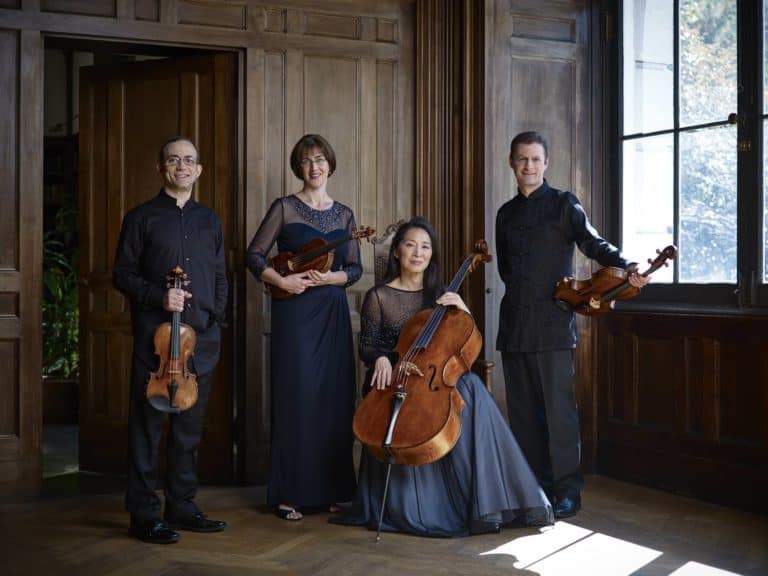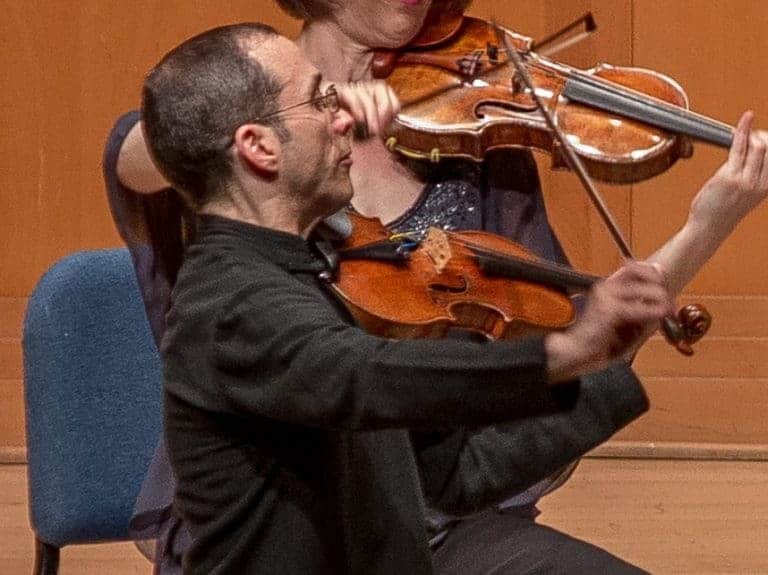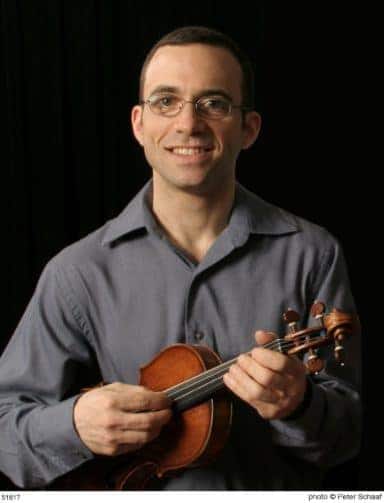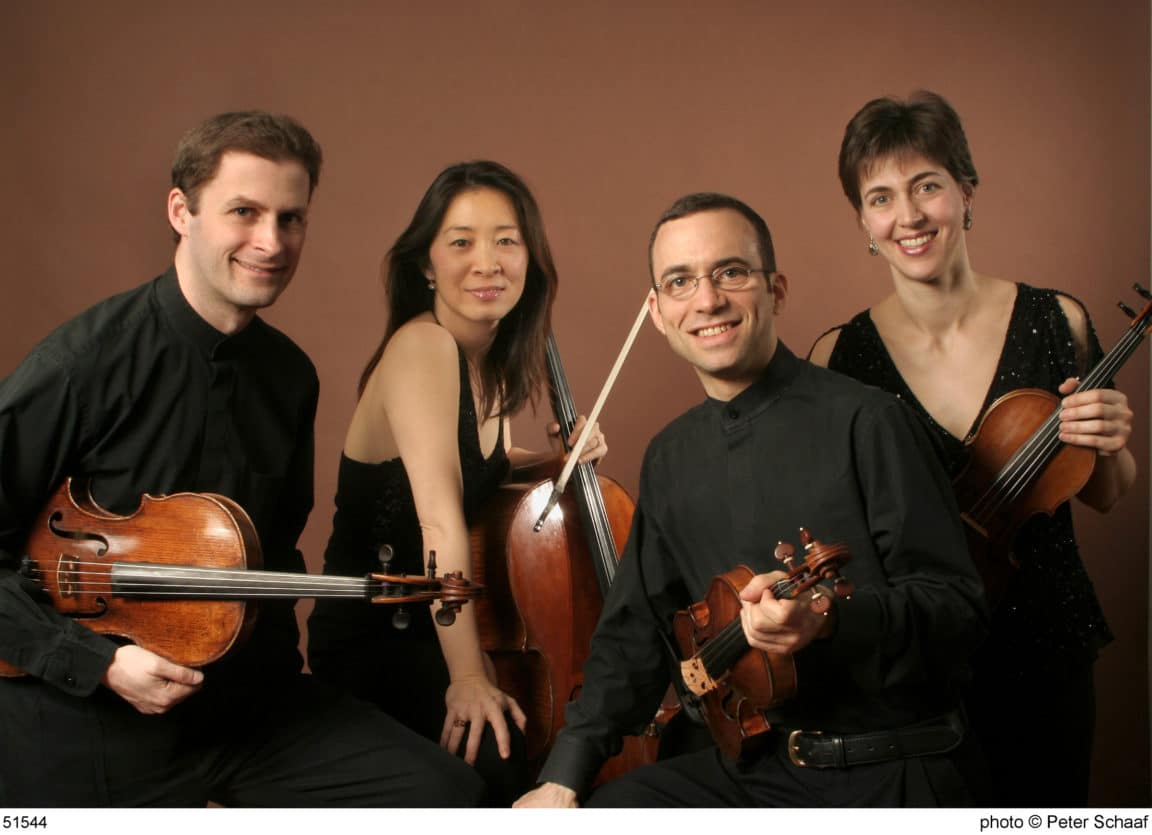The Brentano String Quartet‘s name — after Antonie Brentano, Beethoven’s legendary “Immortal Beloved” — adds a romantic flair to a group of musicians already celebrated for being, in the words of the London Independent, “passionate, uninhibited, and spellbinding.”
I would always go out of my way to hear the Brentano (Mark Steinberg and Serena Canin, violins, Misha Amory, viola, and Nina Lee, cello). It’s much more than their technical prowess. There’s something about their playing that convinces me they have surrendered their egos to the music and are committed to doing what each composer most desires.

The quartet returned to Chamber Music Northwest on July 22 and 23 with violist Hsin-Yun Huang to play three seldom heard viola quintets by Mozart, Brahms, and Mendelssohn. First violinist Mark Steinberg graciously submitted to an interview on Friday, July 21 before the group’s scheduled rehearsal. I had talked with Steinberg before and knew him to be poetic and imaginative. He’s small and thin, somewhere in his 40s, with a huge smile and an easy laugh. He seems to have unbounded energy for the task at hand, whether it’s giving an interview or playing an amazingly difficult passage. He talks fast, laughs often, and obviously loves his subject matter.
Why Viola Quintets?
I tell Steinberg that I’ve always loved add-ons to the string quartet and wondered what it is about the viola quintets that is so special. I knew that Mozart had an affinity for this group of instruments, that the viola was his favorite, and that he loved being in the middle of things (the viola’s pitch range lies between the quartet’s cello and violins).
“I think a large part of it is that people just got inspired by Mozart. There’s something about the viola adding another dimension to the quartet — the added texture, layers of counterpoint. Mozart’s viola quintets inspired Beethoven, Mendelssohn, and Brahms. It’s like Haydn with the string quartet. Once people saw how you could do all that with the string quartet, then everyone wanted to try!”
Longevity’s Lessons
The Brentano has just celebrated its 25th anniversary and I congratulated Steinberg on sticking together and growing together, noting that it only makes for more polished performances. He agreed, sort of.
“On the whole it’s a good thing. We do have a lot of shared history to draw on, so we are much better at sounding okay faster. The reason why it sounds okay is that we have our ways of dealing with that language together. But that’s very different from a great performance. Very, very different.”
Steinberg explained that they have to be constantly vigilant to avoid complacency. They ask themselves again and again, “Why do we do it like this? Why did we make this decision?” He feels that as long as they are aware of the the danger, they can avoid it.
I asked if there were any specific occasions where they thought their interpretation of a piece was okay, but they decided to take it in a totally different direction. “Oh, that happens all the time! That’s what’s really good, to be able to make those decisions, the ones that work, and to make them afresh. It’s a wonderful challenge. I love it.”

Group Dynamics
It sounds like the decision making process works well with the Brentano. They never do anything that they don’t all agree on.
“We know each other so well that we know how to talk to each other, and we know how to negotiate conflicts. We know how to find our way together.”
I point out that one of the secrets of their longevity must be that they know how to listen to each other. “Yeah, that’s huge,” he replies. “Young quartets come to me and they ask for advice. And I don’t know…. Every group is different. It’s like Tolstoy.”
Tolstoy?
“Yes,” he replies. “Like in Anna Karenina, where he says ‘Happy families are all alike; every unhappy family is unhappy in its own way.’
“The one thing I tell people, and I feel pretty confident about it, is when you start your quartet you should feel like you just can’t imagine having any problems with these people. Of course, you’re wrong! There’s always surprises, and we’ve certainly had conflicts, but I think we’ve had fewer than a lot of groups. So if you feel like that to begin with, when things come up you’ll probably be able to find a way around it, and how to talk to each other with mutual respect and a good attitude. You don’t go in thinking, ‘Well, I don’t have a very good feeling about this person but we’ll work it out later.’”
String Quartet Soap Operas
About five years ago, the movie A Late Quartet starred Philip Seymour Hoffman as a troubled second violinist with a troubled marriage to the beautiful violist. Add into the mix a philandering first violinist and their beloved leader, a cellist with recently diagnosed Parkinson’s Disease. The melodrama is played out over a lovely background of Beethoven’s “late quartet,” No. 131, recorded by the Brentano Quartet, which I didn’t realize until I saw the credits at the end.
“Thank goodness we’re not that quartet!” Steinberg said, and we both laughed.
“We read the script long before the filming happened and the director asked for our input. It was a bit of a soap opera for me. We all said, that’s ridiculous. That would never happen. No way. But it turns out that those were stories he got from actual quartets. Of course to have them all converge in one group is unusual, but some of the things that seemed wildly implausible to me actually came from real life. For example, if someone leaves a quartet, that person is not the one who dictates their replacement. It’s up to the people who remain. But apparently with the Guarneri Quartet, David Soyer said that Peter Wiley was the only person who could replace him. I was shocked. Shows how much I know.”
We agreed that the Guarneri did fine after that and retired in 2009 after 45 years.
Early Music
The Brentano is known for its affinity for very early and very contemporary music. I asked if this was just Steinberg’s preference or the whole quartet’s.
“Oh no, no, no. We only do things we all want to do. Right now we’re doing an hour-long concert of early music: Orlando di Lasso, Richard Mico, an English consort composer, Josquin des Prez, Gesualdo, and Monteverdi.”

I asked how he felt about playing that kind of music on modern instruments. “Great!” he replied without hesitation. “Actually, none of what we’re playing was written for the violin family of instruments in any guise. Everything is either vocal music or viol music. Of course, the viols are close to violins, they’re not unrelated, but it’s a different family. The instrument is constructed differently and you hold the bow differently. But I think these pieces work. What’s most important is what you hear in your own inner ear.
“When we do the vocal music, we pay attention to how the text shapes the music in terms of its meaning, but also to the sounds of the words. In a lot of madrigals, the composers have left their residue in the writing. Gesualdo’s madrigals, for example, are so mercurial. Most madrigals are very dark and impassioned — a lot of death. And suddenly the word ‘joy’ will come up, even in the negative, like, ‘I will no longer have joy.’ But when the words arrive, there is a flowering of joy written right into the music. You can still feel the words because he’s written them into the textures and the gestures of the sound.”
What’s New
The Brentano is commissioning a lot of new music, which Steinberg is very excited about. He rattled off a list of renowned contemporary composers. The Brentano had just gotten a second string quartet from Stephen Hartke (“a wonderful piece, which we love”). Martin Bresnick is going to write quartets for them, and Steven Mackey and James MacMillan will compose viola quintets, which is particularly gratifying since violist Hsin-Yun Huang is married to Brentano violist Misha Amory and considered part of the Brentano family. They had just played MacMillan’s horn quintet (“a terrific piece”). The Brentano has issued two recordings with Mackey: Speak Like The People, Write Like The King, and String Theory: The Brentano String Quartet Performs the Music of Stephen Mackey.Then the brilliant 27-year old composer, conductor, poet, pianist, and critic Matthew Aucoin will be writing two pieces for them: a short quartet and a full-length one.
In addition to commissioning, the Brentanos enjoy collaborating. They have ongoing collaborations with several well known artists, such as pianists Mitsuko Uchida, and Jonathan Biss. They are currently arranging some Strauss and Debussy songs for the esteemed singer Joyce DiDonato, and will be performing some Schoenberg quartets with another masterful singer, Dawn Upshaw.
Journey Inside a Fugue
In keeping with the Brentanos’ love of old music, they have developed an ingenious way to present J.S. Bach’s Art of Fugue in multi-media concerts. Steinberg believes that Bach probably intended it to be a keyboard work, although nobody knows for sure, but it works well for string quartet. “When you have an individual identified with each strand of the counterpoint, in some ways it clarifies things. But it’s a lot to ask of an audience.”
He contrasts it to The Well Tempered Clavier, where the preludes break up the fugues, and each one is in a different key and on a different subject. “But The Art of Fugue is all fugues, all the time, all in the same key, and all the same subject for an hour and 20 minutes. I don’t think Bach ever expected someone to sit down and listen to it from beginning to end, but we wanted to do that. So we needed to find a way to help people understand what it is to be inside a fugue.”
To get people “inside” the fugues, Steinberg selected readings to be interspersed with the music, among them a May Swenson poem called “DNA Molecule” about the double helix and how it twists and turns around itself, a reading from Carl Sagan’s Cosmos documentary, “One Voice in the Cosmic Fugue,” and one comparing fugal technique to Cubism. “I thought that was very apt,” he explained “because with a Cubist painting, you can see all the sides at once.”
Then they commissioned a short play in the form of a fugue by Itamar Moses. Despite initial objections — “We are not actors and we can’t do that, that’s ridiculous,” — the Quartet wound up acting it themselves in the premiere at the 92nd Street Y in New York City. “I start with a stupid joke and then start talking about a fugue,” Steinberg says. “Then Serena [Brentano’s second violinist] says the same joke and then we start talking, and then Misha comes in and says the same joke. People get it instantly — that it’s a fugue. People really loved it.”
The performance’s pièce de résistance was an enormous moving sculpture designed by architect Gabriel Calatrava. Steinberg describes the sculpture as inspired by Bach but also by the children’s game of cat’s cradle. It consists of many strings (ropes) stretched across the stage, which can be moved into different configurations by a troupe of four to six dancers moving inside the strings, imitating the lines of a fugue.
“They choreographed five of the fugues. We didn’t want them to choreograph everything because we wanted the focus to be on listening.”
The Brentano presented this performance again with Da Camera in Houston, but the expense of shipping the huge sculpture makes it too difficult to take all around the country. When I expressed disappointment, Steinberg mentioned that he’s talking to the Portland projection artist Craig Winslow about making a new version of the performance that is more practical and portable.
“Do you think this may be a way to expand the scope of chamber music,” I asked, voicing the perennial problem, “so that people who wouldn’t ordinarily be interested might discover it?”
“Yes, absolutely,” Steinberg insists. “I think as a culture we’re more oriented toward visual images and the spoken word than we are toward music. So making analogies with those things helps people find what’s resonant for them. We’re not just trying to add something to make it look more flashy, but to illuminate something true about the music, something that people can discover when the come to hear it.”
When I asked if they had any new multi-media productions planned, he burst out laughing. “It could happen, but the Bach thing nearly killed me. I had something like 35 meetings with people trying to put it together. Well, I have some ideas in my head, so we’ll see where they go.”
I certainly hope they manage to put something together and bring it to Portland. Or bring one of their awesome collaborations. Or at least come back to play for us again.




